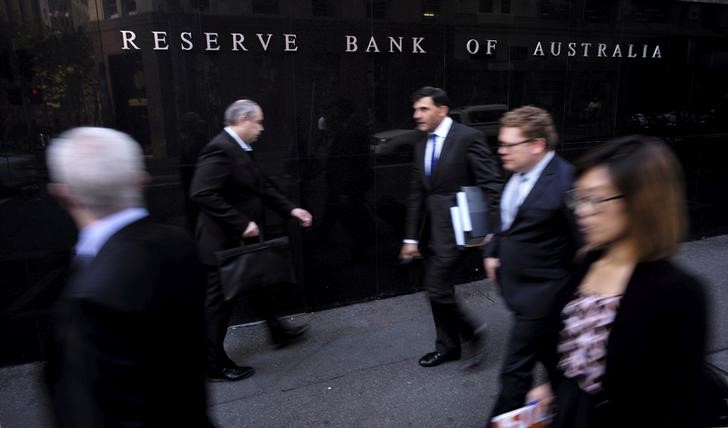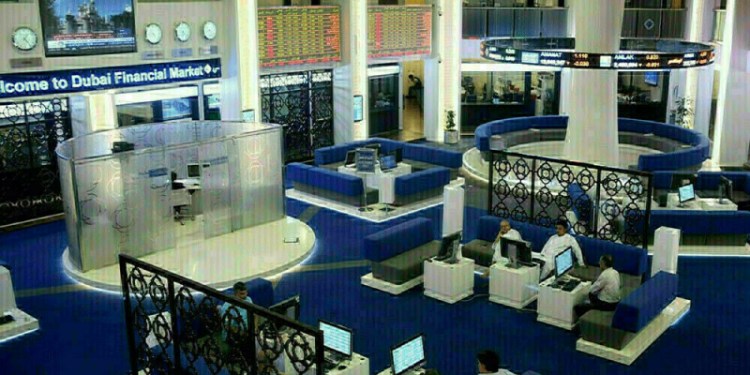 © Reuters. FILE PHOTO: Business people walk outside the Reserve Bank of Australia in Sydney
© Reuters. FILE PHOTO: Business people walk outside the Reserve Bank of Australia in SydneySYDNEY (Reuters) – Australia’s central bank sees faster economic growth this year and next but doubts inflation will reach the mid-point of its target band until 2020, a strong signal rates are set to stay at record lows for a good while yet.
The Reserve Bank of Australia (RBA) expects growth in the A$1.8 trillion economy to accelerate to 3.25 percent by the end of this year before peaking at 3.5 percent by June 2019.
The upbeat outlook is likely to be echoed by Treasurer Scott Morrison next week when he hands down, what is likely to be, his last annual budget before the next general election.
In a 65-page statement on monetary policy on Friday, the RBA left growth forecasts unchanged from its February outlook, while estimates for inflation and unemployment this year were nudged up a little.
The jobless rate is seen lingering around current levels of 5.5 percent this year before easing to 5.25 percent by mid-2019 and staying there to 2020. The RBA had earlier predicted unemployment would slip to 5.25 percent by mid-2018.
Underlying inflation is now seen at the floor of its 2-3 percent target band by mid-2018, but is still not expected to reach 2.25 percent until June 2020.
Governor Philip Lowe pointed to subdued wages growth, at 2 percent, as a major factor weighing on inflation, but held out hope for a pick as the economy revives and the labor market tightens.
“Overall, the Australian economy is progressing broadly on the track the Bank has been expecting for a while. The current accommodative stance of monetary policy has assisted this outcome,” Lowe said.
“If the economy continues to perform as expected, higher interest rates are likely to be appropriate at some time,” he added.
“Notwithstanding this, the Board does not see a strong case for a near-term adjustment in the cash rate.”
Inflation has remained below the RBA’s target since early 2015 and was the single biggest reason the central bank cut interest rates to an all-time low of 1.50 percent in August 2016.
At its policy meeting this week, the RBA held rates for a 21st straight month and signaled a stable policy for some time yet.
SPARE CAPACITY TO 2020
The Bank was upbeat about domestic output growth aided by a broad-based pick-up in global activity and government spending on infrastructure, which is lifting non-mining investment.
Boosting the RBA’s confidence, corporate profits are surging and measures of business confidence and condition are strong.
All that has led to a surge in employment with annual jobs growth of 3 percent, much faster than the 1.6 percent rise in population and more than twice the pace of U.S. job creation.
The RBA expects the labor market to strengthen further, but still sees spare capacity lingering well into 2020.
One source of uncertainty is the outlook for household consumption, which has held up so far despite weak income growth and high indebtedness.
The household debt-to-income ratio in Australia has surged to a record high 190 percent, worrying policy makers who took steps last year to rein in lending to property investors.
Lowe sounded relaxed about easing conditions in Sydney and Melbourne housing markets as the flow of new borrowing has slowed and credit standards have tightened.
A further slowdown in lending could come as Australia’s major banks face a powerful judicial inquiry which has already unearthed a litany of misdeeds.
Lowe also pointed to risks in the international arena such as rising protectionism that could affect outcomes for the export-heavy nation.
Source: Investing.com




























